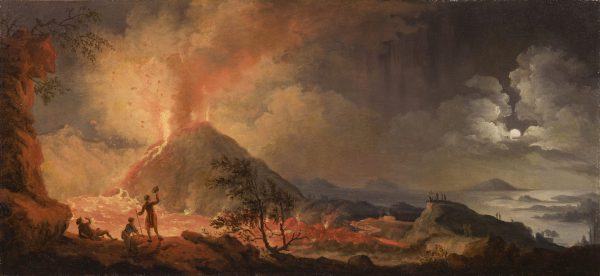The eruption of mount Vesuvius from he Atrio del Cavallo, Ca. 1780.
Oil on canvas, H. 0.38 m; W. 0.81 m
Provenance: Private collection, France.
Born into a family of artists, Pierre-Jacques Volaire, also called « le chevalier Volaire», was initially formed under his father, peintre officiel in Toulon. The beginning of his career is marked with the arrival, in 1754, of Joseph Vernet in Toulon, who was commissioned by Louis XV to paint the harbors of France. For eight years Volaire accompanied the Avignon artist on his wanderings, and their collaboration would have a decisive influence on the future course of his artistic career.
In 1764, Volaire set out for Italia. After several years in Rome, where he was admitted to the Academy of St Luke, he settled permanently in Naples in 1769. Soon he distinguished himself as a specialist in depicting the eruptions of Mount Vesuvius, painting the most spectacular of these (which he witnessed in 1771) more than a dozen times. Volaire’s paintings piqued the scientific curiosity of his day, and were highly prized by voyageurs amateurs.
Set in moonlight, most of Volaire’s compositions contrast the fiery red and warm yellow hues of the lava with the harsher and darker colours of the night, with the light reflecting on the Bay of Naples. The diminutive spectators in the foreground remind us not only of man’s insignificance in the face of natural forces, but also reflect our own instinctive reactions, as they all assume totally different attitudes during the event. Vesuvius erupting as seen from the Atrio del Cavallo with the Bay of Naples beyond is his best-known composition.
